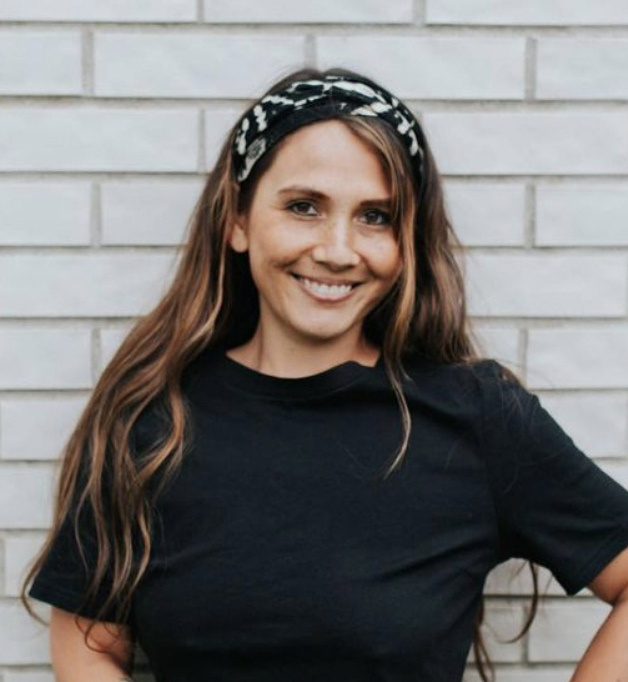Hiring product design consultants often feels like a blind date - you have to hope your friend knows exactly what you need in a partner. At Bitovi, we match product designers with projects based on the depth and breadth of their experience, their unique skills, and your project’s needs. Well-rounded product design teams should have people experienced in both B2C and B2B platforms. They should be able to design end-to-end for mobile, native apps, or desktop experiences. They should be proficient with common design tools. And they should be active problem solvers.
But great product designers have more than technical skills and resume chops. The best design teams are diverse, with people from different walks of life who care about different things and approach things differently. Great teams may all be experts in the design field, but each person individually brings new flavors, methods, and differing mindsets to all the magic.
So, what are the things to look for in product designers, and how do you build a strong design team? In this blog post, I’ll introduce you to some designer personas I think every great product design team should strive to have. It goes without saying - design teams should never be homogeneous. Ensuring everyone isn't the same in terms of race, gender, geographical location, and culture is a great start. But beyond that, there are so many personal, individual qualities that make designers fantastic assets to your technology and product team. Let’s dive in!
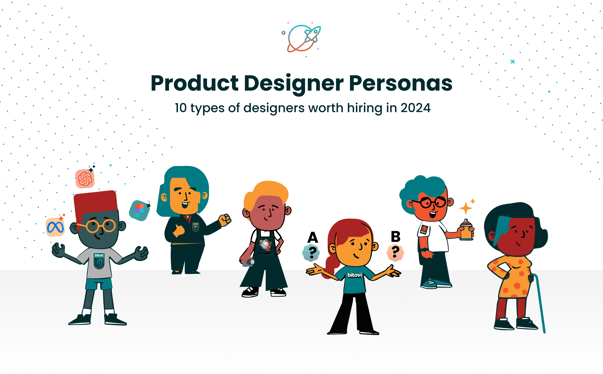
Product Design Categories for Hiring
First, let’s explore some high-level categories we consider when hiring product designers.
Curiosity & Empathy
“Curiosity & Empathy” is a big one. Excellent product designers always ask questions and empathize with their end users. In the absence of curiosity, solutions will fall sub-par. Without continuously building empathy, solutions will not meet human needs or solve the right problems. Read on to meet the curious and empathetic “types.”
Craft & Clarity
Next is “Craft & Clarity.” Design is art, and even when it’s not visual (not all product designers work with visual elements), crafting clarity is highly important. It’s a design thinking principle for a reason. You can’t have human-friendly designs without ensuring clarity and understanding. And it takes a thoughtful designer, an expert in their craft, to bring that clarity to the surface.
Technology & Expertise
”Technology & Expertise” is the one most people focus on. Of course, when we hire product designers, they should be experts in their field and well-versed in the technologies needed to get the job done. But this goes deeper than hiring an amazing techie who checks all the boxes. It’s also about their mindset and their continuous explorations into new technologies coming online every day. Read on to see if you have these experimenter “types” on your team.
Leadership & Longevity
Finally, there’s the “Leadership and Longevity” category. Every product design team needs a leader who will engage other leaders, clients, and communities, inspiring the teams they oversee. Every great product design team has at least one seasoned leader in it for the long haul, someone who can confidently guide their team into the future. Let’s face it - some companies out there struggle with year-over-year turnover and inconsistent leadership at all levels of design and product. Those teams often face challenges delivering impactful, sustainable design solutions because they lack longevity. In 2024, make sure you’re investing in longevity leaders!
Now that you know the categories, let’s meet the squad.
Note: Although these are fun characters to stylize, these design personas are not meant to put people into one box. Many great designers fit into several of these categories, which is what makes curating a design team so fun! When hiring, use these ideas as a guide, and don’t limit yourself to just these four personas. Explore your own categories that make sense with your given team and product goals.
Curiosity and Empathy in Product Designers
The curious and empathetic types:
“The Curious, People-Lover”
“The Diplomatic Ideas Tester”
”The Challenger / Advocate”
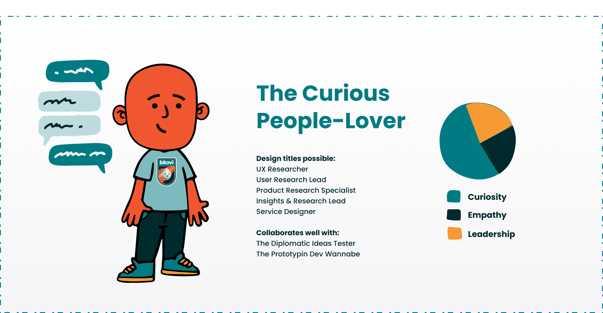
The Curious People-Lover
Introducing the product designer who will always ask about the research. They are highly concerned with knowing as much as possible about the people they design for, and they’ll constantly advocate for more research. Their heart is in the people. They can’t wait to meet with users, and they’re great at understanding when to bring them into the process. These people are insatiably curious and always down to run a quick study!
What can set them apart from other designers
They often…
- have a background in human psychology
- have experience interviewing and testing with people
- can write, speak, and tell stories effectively
Unique titles in this category
- UX Researcher
- User Research Lead
- Product Research Specialist
- Insights & Research Lead
- Service Designer
Collaborates well with
- The Diplomatic Ideas Tester
- The Prototypin' Dev Wannabe
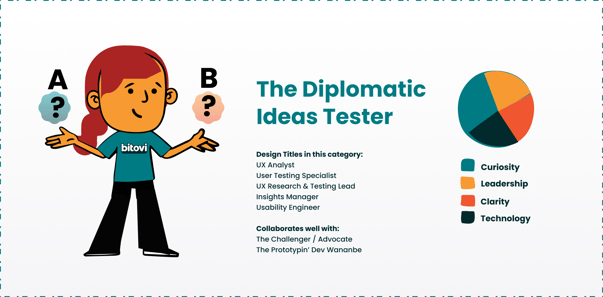
The Diplomatic, Ideas Tester
Introducing the product designer who will socialize and test all your ideas internally. They always ask, “Why?” “Are we sure?, and “Did we test this?” They are highly engaged with the people using their designs and strive to satisfy all user types. In enterprise settings, these people are very diplomatic as they collaborate with and serve various teams and types of users. They understand that ideas require testing and enjoy finding new, scrappy ways to keep users involved in the design process.
What can set them apart from other designers:
They often...
- have experience in various testing methodologies
- are diplomatic and confident in selling and advocating for design
- great for leadership tracks and managing internal relationships
Unique titles in this category
- UX Analyst
- User Testing Specialist
- UX Research & Testing Lead
- Insights Manager
- Usability Engineer
Collaborates well with
- The Challenger / Advocate
- The Prototypin' Dev Wannabe
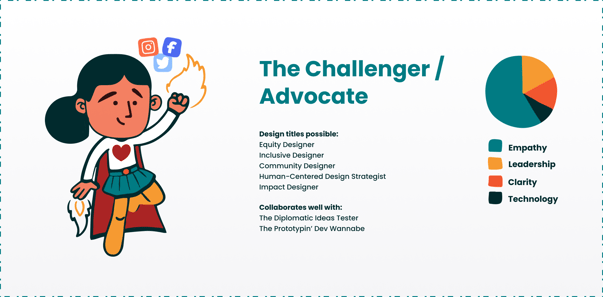
The Challenger / Advocate
Introducing the product designer who will challenge the team. This person is fearless in speaking up about things no one else in the room does. They are highly concerned with advocacy and ensuring the people they design for have a voice, are fairly represented, and are included. Accessibility advocates and community-oriented people fit into this category. They value equity and inclusion and are always looking to make an impact in the world!
What can set them apart from other designers
They often…
-
are part of group communities
-
have accessibility and DEI knowledge
-
have a social media presence
-
and enjoy networking
They might call themselves:
-
Equity Designers
-
Inclusive Designers
-
Community Designers
-
Human-Centered Design Strategists
-
Impact Designers
Collaborates well with:
-
The Diplomatic Ideas Tester
-
The Prototypin' Dev Wannabe
Craft and Clarity in Product Designers
The crafters of clarity:
”The Pixel-Perfect Artist”
”The Prototypin' Dev Wannabe”
”The Word-Lovin' Content Strategist”
The Pixel-Perfect Artist
Introducing the product designer who is a visual artist. They are pixel-perfect designers who are experts in their craft. They can take basic black-and-white concepts and beautify them at the highest level. They turn wireframes into polished mockups. These designers are often part of the bigger brand and design system team, ruthlessly paying attention to foundational elements like color, type, spacing, and layout.
What can set them apart from other designers:
They often…
- have an arts background
- can help create other graphics & presentation assets
- help establish governance and consistency in your brand
They might call themselves:
- UI Designer
- Visual Designer
- Concept Artist
- Visual UI Designer
Collaborates well with:
- The Word Lovin' Content Strategist
- The Prototypin' Dev Wannabe
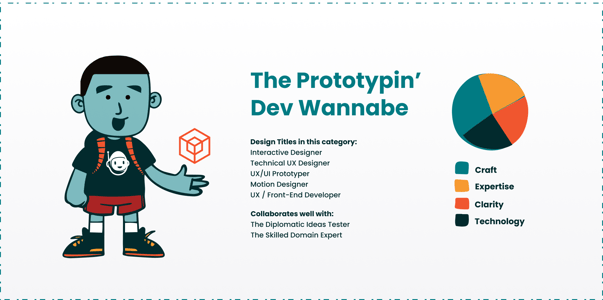
The Prototypin' Dev Wannabe
Introducing the product designer who will prototype like a developer. This person is highly technical and loves to simulate the animations and motions in their designs. They might have a development background, often thinking about the code required to bring their visions to life. They’re usually proficient in the best design/dev tools. Your team can trust this person for high-fidelity prototypes!
What can set them apart from other designers:
They often...
- mix well with developers (or come from a dev background)
- know about code
- understand interaction design on a deeper level
They might call themselves:
- Interactive Designer
- Technical UX Designer
- UX/UI Prototyper
- Motion Designer
- UX/Front-End Developer
Collaborates well with:
- The Diplomatic Ideas Tester
- The Skilled Domain Expert
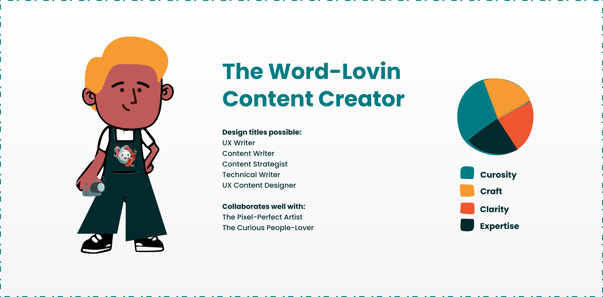
The Word-Lovin Content Creator
Introducing the product designer who can write! These designers have no problem turning Lorem Ipsum blocks into real copy. They are passionate about combining words and visuals, often with the skills to design web content like icons and illustrations. Like the curious ones, they have a knack for knowing what users want and what they want to hear (or, should I say, read). When it comes to web copy, trust the word lovers to create content that sells!
What can set them apart from other designers:
They often…
- have strong writing and editing skills
- can work with photography, video, and media
- have excellent presentation design skills
- work well with marketing & sales
They might call themselves:
- UX Writer
- Content Writer
- Content Strategist
- Technical Writer
- UX Content Designer
Collaborates well with:
- The Pixel-Perfect Artist
- The Curious People-Lover
Technology Prowess and Expertise in Product Designers
The skilled techies:
“The Tech Guru Experimenter”
“The Skilled Domain Expert”
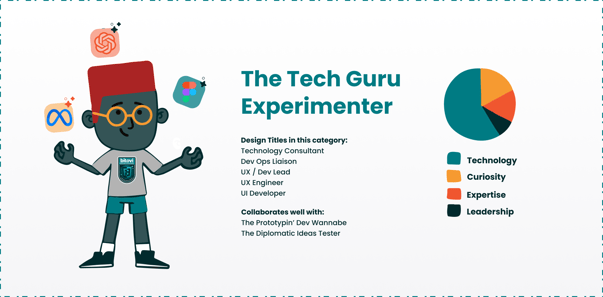
The Tech Guru Experimenter
Introducing the product designer who is always keen on all the latest tech trends! You know the type, they regularly deep dive into how to use Chat GTP to get the job done smarter, swifter. The person who always shares articles and tips on how to use the latest Figma plugins. The one super excited about AI and who’s always tinkering with the latest. Team dynamics are so much better with a tech enthusiast on the team!
What can set them apart from other designers:
They often...
- experiment with the latest technologies
- do things like stream content or 3D print on the side
- can train your team or clients
They might call themselves:
- Technology Consultant
- DevOps Liaison
- UX / Dev Lead
- UX Engineer
- UI Developer
Collaborates well with:
- The Protoypin' Dev Wannabe
- The Diplomatic Ideas Tester
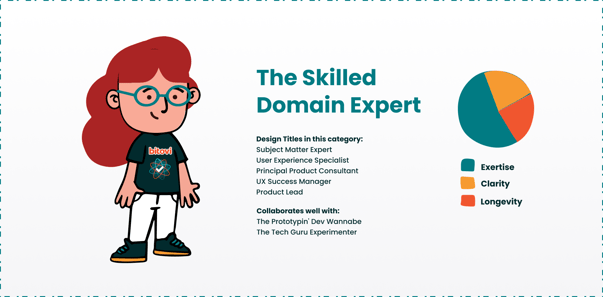
The Skilled Domain Expert
Introducing the product designer who is the expert on your product and services. This person is like an encyclopedia when it comes to your user base, your current usability issues, user requests, and how the product works inside out. People come to them for knowledge, and they often position themselves into niche roles due to their depth of wisdom and support they can offer their teams. Enterprise product teams should all have SMEs!
What can set them apart from other designers:
They often...
- like to go deep and intimately understand data
- pair well with designers less steeped in the product
- have relationships with end users and/or sales leads
- can be customer-facing success agents
They might call themselves:
- Subject Matter Expert
- User Experience Specialist
- Principal Product Consultant
- UX Success Manager
- Product Lead
Collaborates well with:
- The Prototypin' Dev Wannabe
- The Tech Guru Experimenter
Leadership and Longevity in Product Designers
The longevity leaders:
”The Proven Leader / Mentor”
”The Program-Minded Seller”
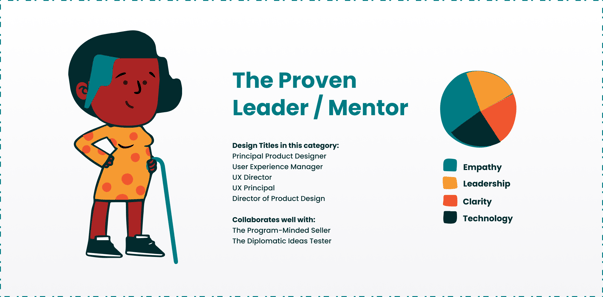
The Proven Leader / Mentor
Introducing the product designer with years of proven experience and leadership acumen. This is the person who inspires the rest of the team. They’re often mentors and hired to lead or build a team. Naturally, they can lead large initiatives and present work at the highest level. All things aligned; these are the leaders who stick around to bring ideas through the entire design process and ensure their teams' work ladders are up to organizational goals.
What can set them apart from other designers:
They often...
- have people management skills
- have led large initiatives, end-to-end
- are motivational and inspiring
- and open to mentoring others
They might call themselves:
- Principal Product Designer
- User Experience Manager
- UX Director
- UX Principal
- Director of Product Design
Collaborates well with:
- The Program-Minded Seller
- The Diplomatic Ideas Tester
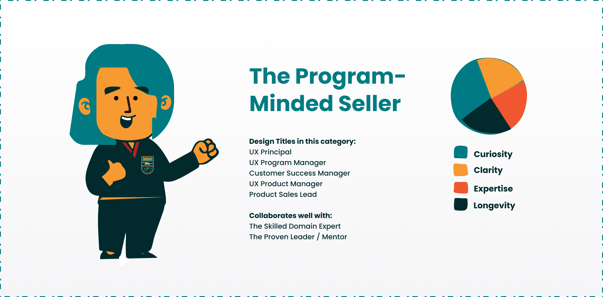
The Program-Minded Seller
Introducing the product designer who thinks about the bigger product and program strategies. This person is a natural leader and salesperson. They’re often designing out big-picture concepts for leadership teams and, for this reason, are significant assets to sales teams. Sometimes, they’re responsible for customer satisfaction and/or sales leads and are asked to oversee multi-year design initiatives or “programs.”
What can set them apart from other designers:
They often…
- have sales acumen
- enjoy connecting people and ideas
- think strategically and long-term
They might call themselves:
- UX Principal
- UX Program Manager
- Customer Success Manager
- UX Product Manager
- Product Sales Lead
Collaborates well with:
- The Skilled Domain Expert
- The Proven Leader / Mentor
Conclusion
Hiring product designers in 2024 shouldn’t be intimidating. Make it fun, and feel free to reference the above list of categories or make your own to understand your current team. Which of the designers you met above may be missing? What are your team's current strengths, and where might there be an imbalance?
Here at Bitovi, our product designers are a diverse group of consultants working remotely from all over the globe. We have curious researchers, tech gurus, prototypers, and content strategists, all with diverse backgrounds and fresh perspectives. We hope this list of designer personas inspired you to look at your team in a whole new way this year. 2024 and beyond brings a whole plethora of people designing and working in unique ways. Take advantage!
Come hang out with us on our Community Discord. We’re always talking about best practices, new developments in design, and (of course) the projects you’re working on.
Previous Post


